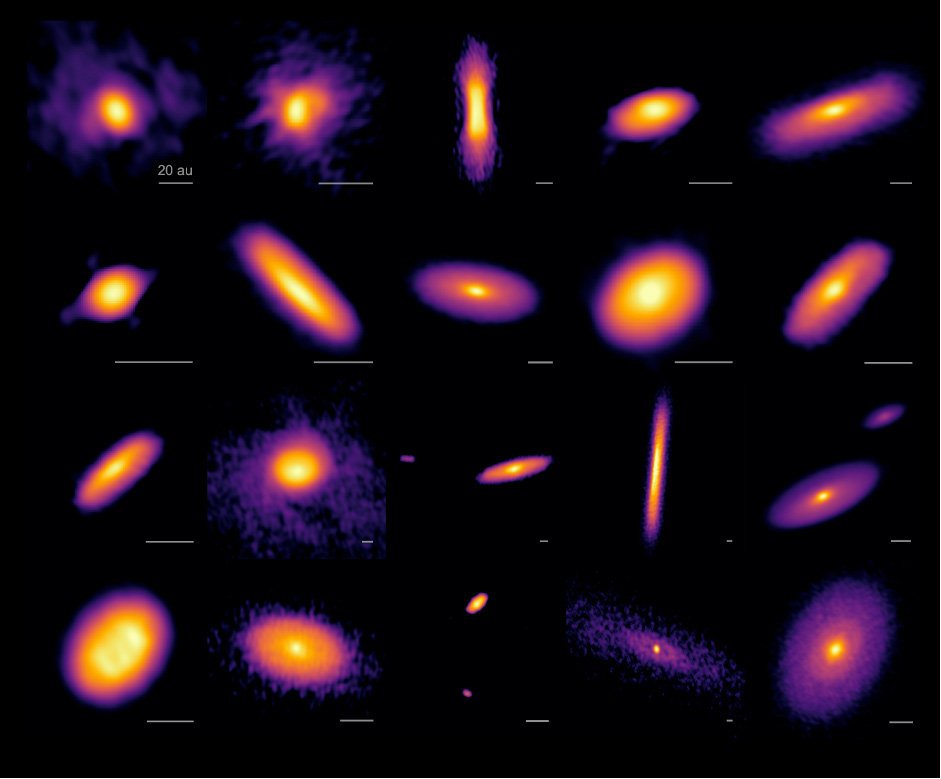Using the Atacama Large Millimeter/Submillimeter Array (ALMA) astronomical observatory in Chile, an international research team has observed disks around 19 protostars with a very high resolution, unearthing further clues about the earliest signs of planet formation. The survey, which resulted in a series of publications in the Astrophysical Journal, was motivated by previous findings that planet formation may be well-underway in the more-evolved proto-planetary disks that have been studied in detail with ALMA. But until now, there had been no systematic study to search for signs of plant formation in younger protostellar systems.
The origins of our solar system and extrasolar planetary systems is one of the most important themes in modern astronomy. Our Sun formed about 4.6 billion years ago and all Sun-like stars are created through a similar process. What happens is a disk forms around the newborn star and planets will form within these disks. These ‘proto-planetary’ disks are expected to only last a few million years, creating a limited window of time for forming a planetary system.
With this motivation, the team focused on disks around protostars, systems that are only 10,000 to 100,000 years old, and observed the radio emission emitted from dust grains, i.e., the building blocks of planets, in disks. Previous studies have only observed a small handful of protostars with the resolution necessary to detect signs of planet formation. Utilizing the very high angular resolution of ALMA to examine the structure of the protostellar disks in detail, the team observed disks around 19 protostars located about 650 light-years from the Earth. This is the first systematic study to investigate the detailed structure of disks around a large sample of protostars with such a high angular resolution.

The observations confirmed that there are disks around all the protostars, meaning that the minimum conditions for planet formation are already present in these young protostar systems. However, the observations clearly show that the disks around protostars are different from more-evolved proto-planetary disks. Among the 19 protostars, rings, and gaps, which are signs of planet formation, were observed only in a few disks toward the most evolved protostars. Moreover, the ring structures are less distinct than those seen in the proto-planetary disks.
It was also found that the dust in many disks is not settled in the disk midplane. Rather the dust is aloft, above the disk midplane, making the disks appear vertically thick. In more-evolved disks, in contrast, the dust settles down in the midplane thereby making them appear much thinner. “We did not expect to see such clear differences between disks around protostars and more-evolved disks,” says Nagayoshi Ohashi, leader of the project and research fellow at the Academia Sinica Institute of Astronomy & Astrophysics. John Tobin, a Co-PI of the program at the ³Ô¹ÏÍøÕ¾ Radio Astronomical Observatory in the USA adds, “Our results suggest that disks around protostars are not fully ready for planet formation. We believe that the actual formation of the planetary system progresses rapidly in the 100,000 years to 1,000,000 years after star formation begins.”
Jes Jørgensen, the other Co-PI of the program at the Niels Bohr Institute of University of Copenhagen in Denmark also mentions the importance of international cooperation in planning and implementing such a large-scale program. “There are 37 researchers from 15 research institutes participating in the international research group that promoted this research. In addition, about half of them are graduate students or young researchers who have recently obtained their Ph.D. This research gives many young researchers the opportunity to participate in large-scale international programs, and it can be said that this program plays a major role in nurturing future research and collaboration.”
Kengo Tomida, an associate professor at Tohoku University’s Astronomical Institute who co-lead the theoretical part of the team, notes the challenges this discovery has for theories pertaining to star and disk formation. “When we started this project, we theorists expected that young embedded disks would be compact and commonly have spiral arms because they tend to form in still growing disks. The eDisk results showed us that the first prediction was correct, but we are a little bit surprised to see fewer substructures in the disks than expected.
Publication Details
All papers are published in the Astrophysical Journal
Title: Early Planet Formation in Embedded Disks (eDisk). I. Overview of the Program and First Results
Authors: Nagayoshi Ohashi et al
DOI:
Title: Early Planet Formation in Embedded Disks (eDisk). II. Limited Dust Settling and Prominent Snow Surfaces in the Edge-on Class I Disk IRAS 04302+2247
Authors: Zhe-Yu Daniel Lin et al
DOI:
Title: Early Planet Formation in Embedded Disks (eDisk). III. A First High-resolution View of Submillimeter Continuum and Molecular Line Emission toward the Class 0 Protostar L1527 IRS
Authors: Merel L.R. van ‘t Hoff et al
DOI:
Title: Early Planet Formation in Embedded Disks (eDisk). IV. The Ringed and Warped Structure of the Disk around the Class I Protostar L1489 IRS
Authors: Yoshihide Yamato et al
DOI:








